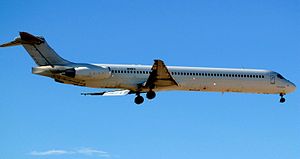- Justice Prisoner and Alien Transportation System
-
Justice Prisoner and Alien Transportation System 
McDonnell Douglas DC-9-83 (MD-83) The Justice Prisoner and Alien Transportation System (JPATS), nicknamed "Con Air",[1] is an agency of the federal government of the United States charged with the transportation of persons in legal custody between prisons, detaining centers, courthouses, and other locations. It is the largest prison transport network in the world.[2] Though primarily used by the Federal Bureau of Prisons or U.S. Immigration and Customs Enforcement, JPATS also assists military and state law enforcement.
The agency is managed by the United States Marshals Service out of the JPATS headquarters in Kansas City, Missouri.[2] JPATS was formed in 1995 from the merger of the Marshals Service air fleet with that of the Immigration and Naturalization Service. JPATS transports more than a quarter million prisoners and aliens each year. Air fleet operations are located in Oklahoma City, Oklahoma, with hubs in Anchorage, Alaska; Mesa, Arizona; Alexandria, Louisiana; and the Virgin Islands. Additionally, the Federal Transfer Center at Oklahoma City's Will Rogers World Airport was built especially to facilitate prisoner transport on JPATS.
Usually, the airline employs Boeing 727 or McDonnell-Douglas MD-83 aircraft to transport convicts and illegal residents of the United States for extradition. Smaller jets and turboprops are also used to transport individual prisoners who are considered particularly dangerous.
According to the Boeing Jetliner Databook, JPATS operates four Boeing 727s. JPATS also operates an additional four McDonnell Douglas MD-80 aircraft.
JPATS aircraft use the ICAO designator DOJ with the callsign JUSTICE.
During ATC Zero immediately after the September 11, 2001 attacks, when the Federal Aviation Administration grounded all civilian air service, JPATS was the only non-military air service allowed to continue flying in U.S. airspace.
Contents
History and evolution
Prior to the existence of JPATS, the transport of federal inmates over long distances was complicated. The process required an escort by two U.S. Marshals, accompanying the inmate on a regular passenger airplane. This posed numerous problems, including danger to civilians, a backlog of marshals needed to perform such escorts, and a high taxpayer expense.
In the early 1970s, the U.S. Marshals were offered a transfer from the Federal Aviation Administration (FAA) of a Boeing 727 aircraft. Though no purpose was originally designated for this plane, one official had the idea of using it for the mass transportation of federal inmates. JPATS' predecessor was the National Prisoner Transportation System of the U.S. Marshals Service.[3]
The airline ultimately improved the efficiency of inmate transportation and made the sight of a shackled commercial airline passenger largely a thing of the past. For a plane full of 200 inmates, only 12 marshals are required. Marshals are trained with aircraft emergency procedures very similar to those flight attendants learn to protect the aircraft's occupants.
JPATS today
Today's JPATS (a.k.a. ConAir) fleet has expanded to ten full-sized aircraft.[2] These planes fly a large series of routes that serve nearly every major U.S. city.
The flight schedule is kept secret from the public, and is known only to those directly involved in its operation. Passengers scheduled to fly are given little advance notice of their flight. There are several benefits of keeping the schedule secret including:
- the location of airplanes is not known to the public (especially to those who may have an interest in sabotaging a flight or harming any of its passengers).
- as inmates are taken by surprise, they cannot plan their own escape or arrange with outsiders to aid their escape from custody.
Passengers aboard a flight are restrained with handcuffs as well as ankle and waist chains which are double or even triple locked. Those who pose additional danger may be given additional restraints, such as reinforced mittens that completely isolate and almost completely immobilize the hands and face masks to prevent biting and spitting.
Flight and seating arrangements are made carefully with the intent to separate inmates who may be of conflict to one another. Members of rival prison gangs may be transported on different days to help reduce the risk of an in-flight incident.
Unlike the practice in most jails, male and female inmates fly together on the same planes.
Prisoners are not physically restrained to the seats due to Federal Aviation Administration safety regulations. This contrasts with the practice on most other modes of transport.
References in pop culture
- The 1997 Nicolas Cage movie Con Air was based on the operations on this airline. "Con Air" was already a nickname for JPATS (historically it had referred to Continental Airlines[citation needed]). The movie portrays the interior of the plane (a C-123 Provider) as a much steelier, more prison-like environment than a typical JPATS 727, which in reality looks much like any other airliner.
- The movie U.S. Marshals depicted the story of a flight from this airline that crashed.
- An episode of the cartoon Freakazoid! takes place on a plane spoofing this airline called "Prison Air."
References
- ^ Con Air: America's High-Flying Paddy Wagon
- ^ a b c Graves, Lucas (June 2010), "Relocating Prisoners", Wired 18 (6): 148–149
- ^ www.usmarshals.gov - History. Retrieved 2009-10-12.
External links
Categories:- Airlines of the United States
- United States Department of Justice agencies
- 1995 establishments
Wikimedia Foundation. 2010.


